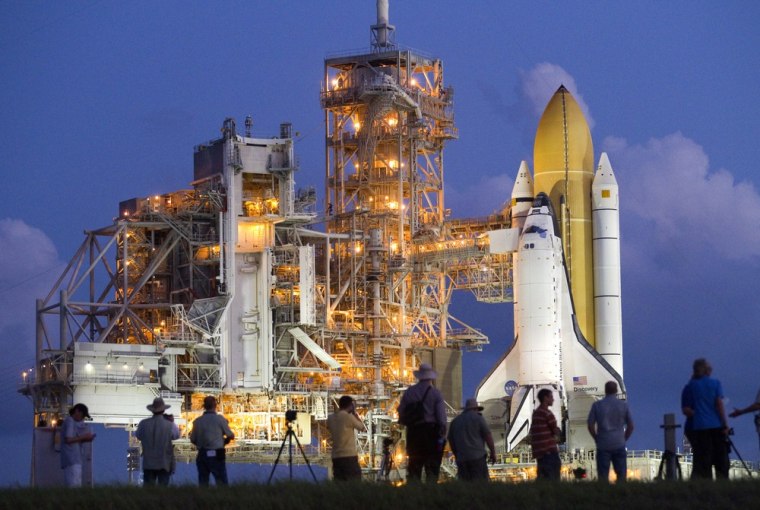The space shuttle Discovery made its last scheduled journey to the launch pad Monday, six weeks before the spacecraft is due to lift off on its final mission to space.
Discovery traveled for about six and a half hours atop a massive, Apollo-era crawler-transporter, lumbering from its voluminous assembly building to the seaside Launch Pad 39A here at NASA's Kennedy Space Center. Hundreds of shuttle workers and their families turned out to cheer the shuttle on during its last launch pad trek.
"This is most likely Discovery's last rollout to the launch pad, so a very momentous occasion for us, but also a very emotional one for a lot of folks," the shuttle's vehicle manager, Stephanie Stilson, told Space.com. "There's a lot of excitement, but also a little bit of sadness over the fact that this will probably be the last one."
The shuttle departed at 7:23 p.m. ET, traveling at the blazing speed of 1 mph (1.6 kilometers per hour) to traverse the 3.4 miles (5.5 kilometers) between the Vehicle Assembly Building and the launch complex. Discovery and its platform were placed on the pad's pedestals at 1:49 a.m. ET Tuesday.
NASA sent out more than 700 invitations to shuttle workers so they could bring their families to watch Discovery's rollout from a viewing area located just near the river rock-lined road that the treaded crawler-transporter followed to the pad.
Discovery is to lift off Nov. 1 on the second-last scheduled mission of the nearly 30-year space shuttle program. The mission will deliver a storage room to the International Space Station and a humanoid robot assistant for the outpost's astronaut crew.
NASA is retiring Discovery and its two sister ships, Atlantis and Endeavour, as it shifts into a new space exploration plan aimed at sending astronauts to visit an asteroid and, ultimately, Mars.
Only two more shuttle flights are currently scheduled. Discovery will fly in November followed by Endeavour in February 2011.
44th and final rollout
Discovery's STS-133 mission will be its 39th and last trip to space, but the shuttle has rolled out to the pad more times than it has launched, due to technical issues. [Photos from Discovery's midnight launch.]
The shuttle's first round trip to the launch pad came in July 1984, before it could launch on its maiden mission. A launch abort required one of the orbiter's three main engines to be replaced before it could safely fly on the STS-41D mission.
The orbiter, NASA's oldest remaining in its fleet, returned to its assembly building (and sometimes its processing hangar) for repairs before launch four more times in its 26-year history.
In 1991, Discovery rolled back for repairs to its cracked hinges before launching on STS-39.
It returned twice to the assembly building due to its external fuel tank being damaged — once in 1995 as a result of a wayward woodpecker poking holes in the tank's foam, and then again in 1999, after a hailstorm riddled the tank with pockmarks.
Discovery's most recent repeated rollout was in May 2005 prior to STS-114, the "return to flight" mission that followed the loss of the space shuttle Columbia. Discovery was reinstalled on an external tank modified with safety improvements.
Stilson has watched over Discovery between flights for 11 missions now, and said some members of her team shed tears when the shuttle left its processing facility for the last time.
"I think I'll be a little more emotional for launch," Stilson said. Discovery's final liftoff, she said, will be the surefire sign that Discovery's spaceflying days are ending, and that it will be heading for the museum at last.
Stilson said Discovery's team of technicians and engineers have kept their focus despite an uncertain future as NASA's space shuttle program winds down. NASA and its contractors have been laying off some workers as operations ramp down. The latest round of layoffs takes effect Oct. 1.
Mission milestones
Discovery's rollout to the launch pad follows its rollover from the orbiter processing facility last week as yet another milestone along the path to its final mission.
Now that it's been placed on the pad, Discovery will continue to be readied for its November launch. One of the biggest tasks is to put Discovery's primary payload, the Leonardo logistics module, in the cargo bay. The module is a modified moving van that previously carried supplies to and from the space station, and will now serve as a permanent storage closet at the station.
The orbiter and its six-person STS-133 crew will undergo a dress rehearsal for the launch on Oct. 15. The Terminal Countdown Demonstration Test will proceed through a countdown as if it were launch day, but stop before the engines are ignited.
Discovery's final flight will set the stage for the shuttle fleet's scheduled finale. The STS-134 mission is slated to be flown by Endeavour in late February 2011 to deliver the Alpha Magnetic Spectrometer, a cosmic ray detector, to the space station. NASA is hoping for an extra shuttle flight on Atlantis, but that mission has not yet been approved by Congress.
If Congress does not give its go-ahead for the extra mission, the space shuttle program will come to an end just a few months before its 30th anniversary on April 12, 2011.
- Gallery - Shuttle Discovery's Midnight Launch
- Graphic: Inside and Out – the International Space Station
- Final Countdown: A Guide to NASA's Last Space Shuttle Missions
This report was updated by msnbc.com, and Space.com managing editor Tariq Malik contributed information from New York City.
